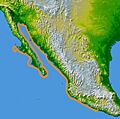Francisco de Ulloa facts for kids
Quick facts for kids
Francisco de Ulloa
|
|
|---|---|
| Born |
Francisco de Ulloa
Spain
|
| Died | 1540 |
| Occupation | Explorer |
| Known for | Exploring the west coast of Mexico |
Francisco de Ulloa (died 1540) was a brave Spanish explorer. He sailed along the west coast of what is now Mexico. He also explored the Baja California Peninsula.
Ulloa worked for Hernán Cortés, a famous Spanish leader. His journey was one of the first to show that California was a peninsula (land almost surrounded by water), not an island.
Contents
Ulloa's Early Life and Adventures
We don't know much about Francisco de Ulloa's early life. We also don't know if he joined Cortés on his first trip to New Spain (which is now Mexico).
One historian, Bernal Díaz del Castillo, wrote that Ulloa came to Mexico later. He arrived carrying letters for Cortés from his wife. Some early writers say Ulloa helped Cortés take over the Aztec capital, Tenochtitlan, using ships.
Exploring the Pacific Coast
In 1539, Hernán Cortés paid for Ulloa to go on an important journey. Ulloa set sail from Acapulco with three small ships. His goal was to explore the Pacific Coast.
He also hoped to find a sea route through North America. People thought this route, called a "northern passage," might lead to the Gulf of St. Lawrence.
The Journey Begins
The expedition started on July 8. They sailed north along the coast. About six weeks later, they reached the Gulf of California. Ulloa named it the "Sea of Cortés" to honor his boss.
One of his ships was lost in a storm. Ulloa stopped to fix the other two ships. He then continued his journey on September 12. He eventually reached the very top of the Gulf.
Sailing Around Baja California
Ulloa could not find the northern passage he was looking for. So, he turned his ships south. He sailed along the eastern coast of the Baja California Peninsula.
He stopped at the Bay of La Paz to get wood and water. Then, Ulloa sailed around the tip of the peninsula. This part of the journey was very difficult.
After rounding the tip, he sailed north along the western side of the peninsula. This area faces the Pacific Ocean.
Challenges and Discoveries
The voyage reached about 28 degrees north, near Isla de Cedros. Ulloa faced strong winds and huge waves. These conditions made it very hard to continue.
It's not clear if Ulloa kept sailing north or turned back. A letter he wrote to Cortés on April 5 suggested he wanted to keep going north. Some believe his ship was lost after that.
However, there are no records saying his ship was lost. Also, later maps from another explorer, Juan Rodríguez Cabrillo, showed details of this part of the peninsula. This suggests Ulloa returned to New Spain and shared his discoveries with mapmakers.
Ulloa's Legacy
Ulloa's explorations showed that Baja California was a peninsula, not an island. But for a long time, maps still showed California as an island. It took until the 1700s for people to fully accept Ulloa's discovery.
His journey was very important for understanding the geography of North America.
Images for kids
See also
 In Spanish: Francisco de Ulloa para niños
In Spanish: Francisco de Ulloa para niños


